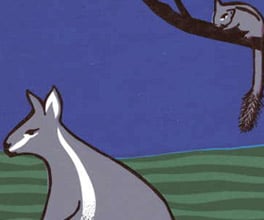Extinction
Settlement has put pressure on the Australian ecosystem from the very beginnings of colonisation. In 1799 a sealing base was established at Kent Bay, near Western Port, where over 9,000 seals were skinned within five months for processing into seal leather or seal oil. The industry petered out by 1810 due to over-exploitation that almost eradicated the elephant and hair seal entirely.
Extinction pressures increased in the 1830s and 1840s, as squatters' sheep and cattle destroyed grasslands, which led to erosion. As more and more bushland was cleared for farming, native plants were destroyed, and native animals were left without a home. Early colonists also shot native birds and animals for sport.
In 1909, wombats were classified as vermin and in 1919 the native hedge wattle was declared a noxious weed, meaning that it was government policy to exterminate it. Even today, it's possible to obtain permits to kill native birds and animals when they interfere with commercial activities, such as farming and forestry.
Introduced animals, such as cats and foxes, are one of the greatest threats to native animals and birds. Small animals like antechinuses, native rodents and frogs have no defence against these introduced predators. Koalas and possums on the ground are helpless; even bats are stalked by cats. Ground birds – including the Mallee fowl and lyrebird – are in extreme danger, as are any birds feeding on the ground.
20 mammal species have already become extinct in Victoria and the state's faunal emblems – Leadbeater's possum and the helmeted honeyeater – are critically close to extinction. They are just two of the 250 animal species under threat, along with 600 plant species.
Australians are often told that for the last hundred years their country has the world's worst record of mammal extinctions. Unfortunately this is true.
– Chris Johnson, Australia's Mammal Extinctions: A 50,000 Year History
Johnson, C 2006, Australia's mammal extinctions: a 50,000 year history, Cambridge University Press, Port Melbourne, Vic.
Chris Johnson is a Professor in Tropical Ecology and Conservation at James Cook University. If you're not sure about an author's credentials, search for their name online. Academics and other experts are usually very easy to find.
The presence of humans in fragile ecosystems, such as alpine regions, continues to impact native animals. For example, the development of ski resorts has disrupted the habitat of the endangered mountain pygmy-possum. The pygmy-possum also has to contend with the new threat of introduced plants, such as blackberries, which choke the native vegetation it relies on for food and shelter.
In Victoria, the effects of extinction are becoming more and more visible, but the solutions aren't quite as clear. The cause of animal extinction – human interference – is well known, but we continue to place the environment under stress.











